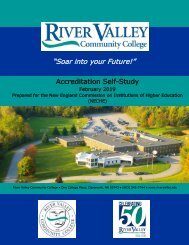Create successful ePaper yourself
Turn your PDF publications into a flip-book with our unique Google optimized e-Paper software.
udget for this program was increased from $7,750 to $8,250 to ensure sufficient supplies<br />
for all students.<br />
Once the budget is approved at the college level, it goes to the CCSNH Office before being<br />
evaluated by the Board of Trustees Finance Committee, the full Board of Trustees, and<br />
ultimately by the State of NH. Weekly budget reports are sent to all Department Chairs,<br />
Department Heads, and Program Coordinators to help them track their fiscal year<br />
expenses.<br />
Each fall and spring a budget forecast is completed to recalibrate the budget and realign<br />
with the needs of <strong>RVCC</strong>. In general, each year, <strong>RVCC</strong> follows a rough estimate that<br />
enrollment between fall and spring semester will decrease by 7% due to attrition. As a<br />
result of this prediction, we recalibrate our year ending revenue for tuition and fees. The<br />
final enrollment numbers in the Fall of 2017 indicated that <strong>RVCC</strong> was down by 6.3%. The<br />
result was to reforecast our tuition revenue from $3.8 million to $3.2 million. At the same<br />
time, a vacant staff position affected our projection for revenue. Thus, the original budget<br />
developed the previous spring decreased from $9.8 million to $9.2 million. Because of this,<br />
there was a need to reduce the general operating expenses by 2%, bringing the original<br />
operating expense budget from $2.176 million to $2.143 million. To do this, we reduced<br />
the hours of operations, including early closures on evenings when there were no classes;<br />
closing the buildings on Saturday; and shifting staff schedules to decrease overtime. As a<br />
result, in Fiscal Year 2018, we were able to save $13,518 in overtime.<br />
Much work has been done in collaboration with the academic department to evaluate<br />
scheduling of courses to maximize building usage and reduce open hours. In Summer of<br />
2018, the College piloted a modified schedule at the Lebanon Academic Center with a<br />
focus on evening hours. This was a result of the evaluation of course tallies which showed<br />
evening classes as the best for student schedules. By continuing to use course tally data<br />
effectively to schedule building hours, we hope to improve the ratio of income vs. expense<br />
at the LAC. This system was re-evaluated after Summer of 2018, and feedback from the<br />
Lebanon Advisory Board and community indicated that they wanted the College to have a<br />
larger presence as opposed to just evening hours. In Fall of 2018, <strong>RVCC</strong> re-opened the<br />
LAC for daytime and evening hours with a focus on increasing usage of the building via<br />
continuing education courses.<br />
As a human capital organization, <strong>RVCC</strong>’s budget has traditionally consisted of roughly 78%<br />
salaries and benefits while other expenses account for roughly 22% of the total costs to<br />
the institution (Figure 7.2)<br />
103 | P a g e





